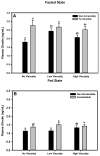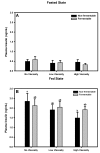The role of viscosity and fermentability of dietary fibers on satiety- and adiposity-related hormones in rats
- PMID: 23749206
- PMCID: PMC3725495
- DOI: 10.3390/nu5062093
The role of viscosity and fermentability of dietary fibers on satiety- and adiposity-related hormones in rats
Abstract
Dietary fiber may contribute to satiety. This study examined the effect of two dietary fiber characteristics, small intestinal contents viscosity and large intestinal fermentability, on satiety-and adiposity-related hormones in rats. Diets contained fiber sources that were non-viscous, somewhat viscous, or highly viscous, and either highly fermentable or non-fermentable, in a 2 × 3 factorial design. In the fed state (2 h postprandial), rats fed non-fermentable fibers had significantly greater plasma GLP-1 concentration than fermentable fibers. In the fasted state, among non-fermentable fibers, viscosity had no effect on GLP-1 concentration. However, among fermentable fibers, greater viscosity reduced GLP-1 concentration. Plasma peptide tyrosine tyrosine (PYY) concentrations in the fasted state were not influenced by the fermentability of the fiber overall, however animals consuming a fructooligosaccharide greater PYY concentration. In both the fed and fasted states, rats fed non-fermentable fibers had a significantly lower plasma ghrelin concentration than rats fed fermentable fibers. In the fasted state, rats fed non-fermentable fibers had a significantly lower plasma leptin concentration than rats fed fermentable fibers. Thus, fermentability and viscosity of dietary fiber interacted in complex ways to influence satiety- and adiposity-related plasma hormone concentrations. However, the results suggest that highly viscous, non-fermentable fibers may limit weight gain and reduce adiposity and non-fermentable fibers, regardless of viscosity, may promote meal termination.
Figures






References
-
- Marciani L., Gowland P.A., Spiller R.C., Manoj P., Moore R.J., Young P., Fillery-Travis A.J. Effect of meal viscosity and nutrients on satiety, intragastric dilution, and emptying assessed by MRI. Am. J. Physiol. Gastrointest. Liver Physiol. 2001;280:G1227–G1233. - PubMed
-
- Leclere C.J., Champ M., Boillot J., Guille G., Lecannu G., Molis C., Bornet F., Krempf M., Delort-Laval J., Galmiche J.P. Role of viscous guar gums in lowering the glycemic response after a solid meal. Am. J. Clin. Nutr. 1994;59:914–921. - PubMed
-
- Rigaud D., Paycha F., Meulemans A., Merrouche M., Mignon M. Effect of psyllium on gastric emptying, hunger feeling and food intake in normal volunteers: A double blind study. Eur. J. Clin. Nutr. 1998;52:239–245. - PubMed
MeSH terms
Substances
LinkOut - more resources
Full Text Sources
Other Literature Sources
Medical

